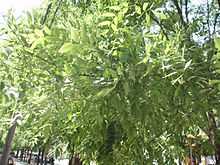Styphnolobium
| Styphnolobium | |
|---|---|
 | |
| Styphnolobium japonicum foliage | |
| Scientific classification | |
| Kingdom: | Plantae |
| (unranked): | Angiosperms |
| (unranked): | Eudicots |
| (unranked): | Rosids |
| Order: | Fabales |
| Family: | Fabaceae |
| Subfamily: | Faboideae |
| Genus: | Styphnolobium Schott |
| Type species | |
| Styphnolobium japonicum (L.) Schott | |
| Species | |
|
9; see text. | |
| Synonyms | |
| |
Styphnolobium is a small genus of three or four species of small trees and shrubs in the subfamily Faboideae of the pea family Fabaceae, formerly included within a broader interpretation of the genus Sophora. It was recently assigned to the unranked, monophyletic Cladrastis clade.[1][2][3] The species of Styphnolobium differ from Sophora in lacking the ability to form symbioses with rhizobia (nitrogen fixing bacteria) on their roots.[4] They also differ from the genus Calia (mescalbeans) in having deciduous leaves and flowers in axillary, not terminal, racemes. The leaves are pinnate, with 9–21 leaflets, and the flowers in pendulous racemes similar to those of the Black locust.
Species
Styphnolobium comprises the following species:[5][6][7]
Section Oresbios
- Styphnolobium affine (Torr. & A. Gray) Walp., the Coralbean or Eve's Necklace is native to the southern United States in Texas, Oklahoma, Arkansas and Louisiana. It is a large shrub or small tree, growing to 5–7 m tall, with white or pale violet flowers.
- Styphnolobium burseroides M. Sousa & Rudd
- Styphnolobium caudatum M. Sousa & Rudd is native to Nicaragua.
- Styphnolobium conzattii (Standl.) M. Sousa & Rudd
- Styphnolobium monteviridis M. Sousa & Rudd is native to Central America.
- Styphnolobium parviflorum M. Sousa & Rudd
- Styphnolobium protantherum M. Sousa & Rudd
- Styphnolobium sporadicum M. Sousa & Rudd
Section Styphnolobium
- Styphnolobium japonicum (L.) Schott, the Pagoda Tree (Chinese Scholar, Japanese pagodatree; syn. Sophora japonica), is native to eastern Asia (mainly China; despite the name, it is introduced in Japan), is a popular ornamental tree in Europe, North America and South Africa, grown for its white flowers, borne in late summer after most other flowering trees have long finished flowering. It grows into a lofty tree 10–20 m tall with an equal spread, and produces a fine, dark brown timber.
Uses
The Pagoda Tree is widely used in bonsai gardening. The Guilty Chinese Scholartree was a historic Pagoda Tree in Beijing, on which the last emperor of the Ming Dynasty, Chongzhen, hanged himself.
S. japonicum (Chinese: 槐; pinyin: huái; formerly Sophora japonica) is one of the 50 fundamental herbs used in traditional Chinese medicine.
References
- ↑ Cardoso D, Pennington RT, de Queiroz LP, Boatwright JS, Van Wyk B-E, Wojciechowski MF, Lavin M. (2013). "Reconstructing the deep-branching relationships of the papilionoid legumes". S Afr J Bot 89: 58–75. doi:10.1016/j.sajb.2013.05.001.
- ↑ Cardoso D, de Queiroz LP, Pennington RT, de Lima HC, Fonty É, Wojciechowski MF, Lavin M. (2012). "Revisiting the phylogeny of papilionoid legumes: new insights from comprehensively sampled early-branching lineages". Am J Bot 99 (12): 1991–2013. doi:10.3732/ajb.1200380.
- ↑ Wojciechowski MF. (2013). "The origin and phylogenetic relationships of the Californian chaparral ‘paleoendemic’ Pickeringia (Leguminosae)". Syst Bot 38 (1): 132–142. doi:10.1600/036364413X662024.
- ↑ Heenan PB, Dawson MI, Wagstaff SJ. (2004). "The relationship of Sophora sect. Edwardsia (Fabaceae) to Sophora tomentosa, the type species of the genus Sophora, observed from DNA sequence data and morphological characters". Bot J Linn Soc 146 (4): 439–446. doi:10.1111/j.1095-8339.2004.00348.x.
- ↑ "ILDIS LegumeWeb entry for Styphnolobium". International Legume Database & Information Service. Cardiff School of Computer Science & Informatics. Retrieved 13 February 2014.
- ↑ USDA, ARS, National Genetic Resources Program. "GRIN species records of Styphnolobium". Germplasm Resources Information Network—(GRIN) [Online Database]. National Germplasm Resources Laboratory, Beltsville, Maryland. Retrieved 13 February 2014.
- ↑ Sousa-Sánchez M, Rudd VE. (1993). "Revisión del género Styphnolobium (Leguminosae: Papilionoideae: Sophoreae)" [Revision of the genus Styphnolobium (Leguminosae: Papilionoideae: Sophoreae)]. Ann Missouri Bot Gard 80: 270–283. doi:10.2307/2399827. ISSN 0026-6493.
External links
| Wikimedia Commons has media related to Styphnolobium japonicum. |
- Styphnolobium japonicum (as Sophora japonica)
- "Chinese Scholar Tree"
- The Evil God in the Pagoda Tree Japanese folktale with the Pagoda Tree at hyakumonogatari.com